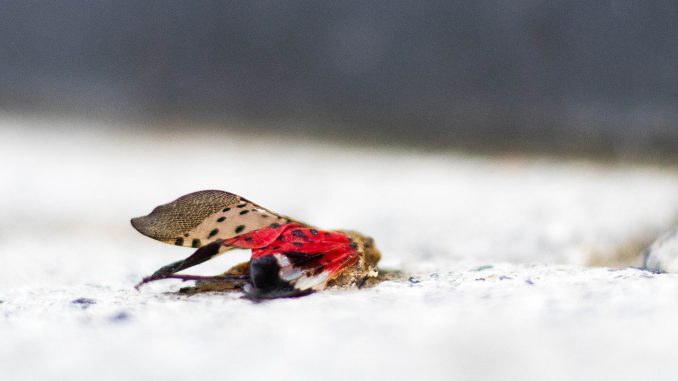
In the bustling area around the Bell Tower, students have found company with a critter relatively new to Temple’s campus but all-too-familiar in Pennsylvania: the spotted lanternfly.
Students told The Temple News they’ve seen lanternflies outside the Morgan Hall Dining Center and Temple University SEPTA Station.
The bugs are an invasive species native to China, India and Vietnam that can cause serious damage to trees, according to the Pennsylvania Department of Agriculture.
The bugs are small, moth-like insects with spotted wings, with few natural predators in the region, according to Penn State Extension, an agricultural education organization. They lay eggs on almost any surface, which has allowed them to spread quickly throughout the southeastern part of Pennsylvania, the site read.
Lanternflies were first spotted in Pennsylvania in Berks County in 2014, which prompted the state’s Department of Agriculture to issue restrictions on the movement of yard waste, firewood and tree parts, among other items in several counties in Eastern Pennsylvania, according to the department’s website.
Reports of the lanternfly in Philadelphia increased from 15 in 2018 to more than 7,700 so far this year, said Shannon Powers, a spokesperson for the state’s department of agriculture. Statewide reports tripled to more than 65,000 during the same period.
Ashley McGrogan, a junior biochemisty major, said the bugs are “digusting” and often have no issue jumping on her.
“They’re a little freaky when they’re huge,” she added.
But the recent influx of the spotted lanternfly on campus has not worried Glenn Eck, Temple’s associate director of ground operations, as the trees he manages have sustained invasions of harmful species before, he said.
“When these sorts of things come through, the thing that we have an advantage here on campus is a very wide variety of trees,” Eck said, adding that he has not seen any damage to trees on campus yet.
“Primarily they’ve just been a nuisance insect, congregating on the buildings,” he added.
Temple Community Garden, a student-run plot at the intersection of Diamond and Carlisle streets, has received several reports of the species around campus from its members, said Sarah DiTomas, a member of the garden.
The insects do the most damage by swarming trees, so the most effective method is to squish the insects and report the swarms, said DiTomas, a junior art therapy major.
“I see people killing them everyday, and there are still somehow even more than ever before,” said Raquel Messina, a freshman global studies major.
TCG, fortunately, has not seen any lanternflies in the garden, said Connor Caruso, its president, but the garden has five trees that could be hurt by the bug.
Members are checking the garden’s trees and plants more frequently now that it has been spotted in the area, said Caruso, who is a senior environmental studies major.
At a general body meeting on Thursday, the garden’s leadership had a presentation on how to spot lanternflies and what types of “good bugs” are helpful in killing them.
“As soon as it became a prevalent issue, it was like, this is now on the list,” said Kayla McKay, the garden’s vice president and a junior landscape architecture major. “This is something to look for, something to educate the club about so now these students know there’s a resource to report them, to kill them.”
Students should not report lanternfly sightings to the Department of Agriculture if they see it on campus, Caruso said, as the state is well aware of its presence in Philadelphia by now.
Matthew Helmus, the principal investigator at Temple’s Integrative Ecology Lab, said the insects generally are attracted to tall buildings and trees around this time of year.
Helmus, who is also a biodiversity and ecology assistant professor, also expects to see nymphs, or baby spotted lanternflies, around this time next year due to their mating cycle, he said.
“It is important to be cautious when traveling for the holidays,” Helmus said. “Anybody traveling with anything the insects could have laid their eggs on will only cause more spreading.”
Eck, who has worked at Temple for 22 years, said the most responsible thing to do is let an invasive species do their damage and replant trees that are resistant to it in the future.
“Generally, when these organisms are part of an invasive landscape, they’re part of the new normal,” Eck added.



I am appalled by Mr Eck’s comments. So is Mr. Eck proposing that we let the lanternfly go completely unchecked and “do their damage” to over 70 species of trees and plants across the country and ruining our agricultural economy? Unchecked this bug will destroy U.S. apple, peach, wine, and hops (beer) industries just to name a few. There are no resistant varieties. In South Korea when left unchecked it spread through the entire country in less than three years and attacked 65% of their plant species. Not to mention when there is an infestation of these bugs it makes being outside unbearable. Mr Eck should be fired. He obviously doesn’t understand that his job is to maintain the grounds, including the trees currently on it, as well as creating a pleasant campus environment for it’s current and prospective students. As a Temple alumni I am hoping Temple steps up and does it’s part. Temple University as a property owner in the city has a responsibility to help control the spread of this invasive bug by doing their part to band trees, remove egg nests, etc.